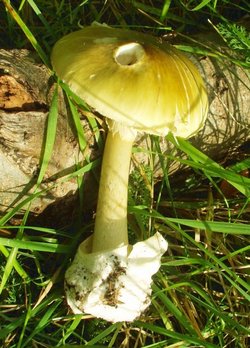Death Cap
|
|
| Death Cap Conservation status: Secure | ||||||||||||||||
|---|---|---|---|---|---|---|---|---|---|---|---|---|---|---|---|---|
 Adult Death Cap | ||||||||||||||||
| Scientific classification | ||||||||||||||||
| ||||||||||||||||
| Binomial name | ||||||||||||||||
| Amanita phalloides |
The Death Cap (Amanita phalloides) is one of numerous poisonous species of mushrooms in the genus Amanita. This is a large and distinctive fungal fruiting body or basidiocarp, usually with a pileus (cap) from 5 to 15 cm across, smooth yellow to brown with a green tinge and a partial veil, white fine lamellae (gills), and a white 4 to 18 cm stipe (stalk) with an annulus and a swollen volva (base). It is found primarily and originally in Europe but now is also in North America, Australia, South America, Asia, and Africa, typically under oaks, nut trees, other hardwoods and some conifers (for example, pines), usually in autumn to early winter. Similar species are A. subjunquillea in eastern Asia and A. arocheae with a range extending from Andean Colombia to central Mexico (at least). All these fungi are mycorrhizal and beneficial to plants. Amanita phalloides is easily exported with conifers and hardwoods.
As the common name suggests it is highly poisonous, responsible for the majority of fatal mushroom poisonings worldwide (see Mushroom poisoning). It contains two types of toxins spread throughout the mushroom thallus: phallotoxins (phalloidin, phalloin, phallisin, phallicidin) and amatoxins (amanitin, amanin, amanullin). The toxin most responsible for the deadly effects of the Death Cap is alpha-amanitin. The poison particularly affects the liver and kidneys; frequently the only treatment for Death Cap poisoning is liver transplant. It is estimated that 50 grams (2 oz) of this mushroom are enough to kill a human.
Asian immigrants in North America and Europe often mistake the Death Cap for the edible Paddy straw mushroom (Volvariella volvacea) due to their similarity in appearance. This is a leading cause of mushroom poisoning in the United States.
One survivor of Death Cap mushroom poisoning described them as "tasting wonderful". She collected the mushrooms in the wild, mistaking them for some gourmet variety she had recently purchased. In many cases of mushroom poisoning, irreparable damage occurs before the onset of symptoms.
External links
- More on this species (http://pluto.njcc.com/~ret/amanita/species/phalloid.html)ca:Amanita phalloides
de:Grüner Knollenblätterpilz fr:Amanite phalloïde ja:タマゴテングタケ nl:Groene knolamaniet pl:Muchomor sromotnikowy fi:Kavalakärpässieni
